FOA Seminars Coming To Middle East In May
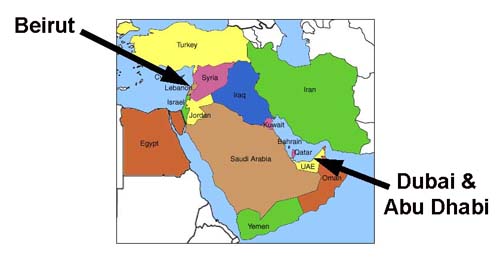
FOA is headed to Dubai, Abu Dhabi and Beirut in May. We'll be
giving seminars in fiber optics and meeting with those working
in the area on fiber networks and FTTH. Here is the schedule and
contacts to register for the seminars:
Dates
|
FOA
Host/School
|
Seminar
Information
|
Contact
To Register
|
May 3
|
Etisalat
Academy,
Dubai
|
"Next
Generation Fibre Technologies:
Latest Fiber Technologies, The importance of skilled
people and certifications."
May 3, 8:30 AM to 12:45 PM
Etisalat Academy, Dubai
|
RSVP to
info@etac.ae by 26th April 2012
|
May 8-9
|
e-sharp
Consultancy,
Dubai & Abu Dhabi
|
“What’s
New In Fiber Optics” Seminar
By The Fiber Optic Association, Inc. (FOA) and e-sharp
Consultancy JLT
Dates:
May 8, 2012 – Dubai
May 9, 2012 – Abu Dhabi
(the exact venue will be confirmed to registered
participants) |
To
register, contact:
Kinneri Nair | Training Coordinator
e-sharp Consultancy JLT
www.esharp.ae
kinneri@esharp.me
P: +971-4-4357684 | F: 971-4-4357681
M: +971-55-8253257
502, Tiffany Towers, Jumeirah Lakes Towers, W2, PO Box
54558, Dubai, UAE |
May 15
|
FTTH
Council MENA, Beirut
|
Fiber
Optics Seminar
To discuss the latest trends of Fiber optics :
-Introduction about FTTH Council MENA and FOA
-What's New in Fiber Optics
-What is the FOA
-Broadband to Users in a Challenging World.
May 15,
2012 from 9am to 1pm at the Ministry of Telecom premises
in Riad El Solh, Beirut.
|
RSVP
with contact information and the number of attendees to:
Ms Christine Beylouni
Director General
FTTH Council MENA
M: +961 70 061601
E: christine.beylouni@ftthcouncilmena.org
|
If you are in the region, contact the proper group and come
meet with us!
FOA scheduled to be
at FiberFest! - JUNE 13, 2012 -

Fiberfest
is the one day conference/trade show run by the New England
Fiberoptic Council. This year the event will be colocated with a
FTTH Council meeting in Boston.
FOA will have a table at FiberFest manned by some of our local
schools. President Jim Hayes will be participating in the FTTH
Council programs.
Look for details here or on the NEFC
website.
US Department of Labor Recognizes FOA In New "Occupational
Outlook Handbook"
FOA is listed in the new US Department of Labor
"Occupational Outlook Handbook" in the section "How
to Become a Line Installer or Repairer."
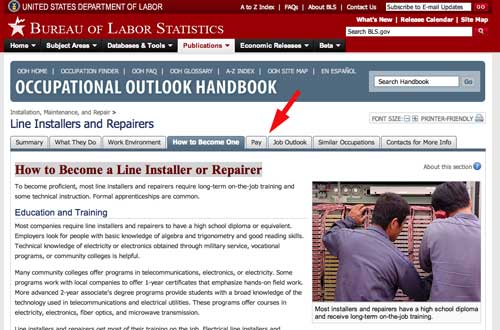
This website lists all sorts of interesting information,
including what these workers do in their jobs, how they get
trained and certified (where the FOA is referenced) and
something everybody is interested in - sections on "Pay" and
"Job Outlook" - see the red arrow above.
Australia's NBN Shows Installation
Schedule
We've covered Australia's National Broadband Network as it has
been designed, but now they are posting information on the
actual rollout by region and city. They've even created a NBN
rollout map to show progress.
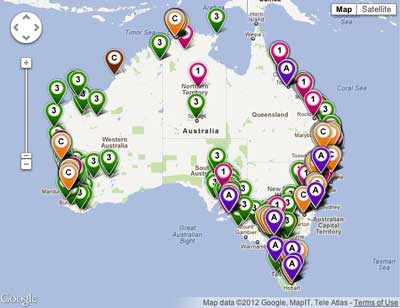
You can see the
enormous list of towns and their status here. Many towns
have detailed maps of the installations that are interesting
too.
Update: Google Fiber - Great for your telecom health!
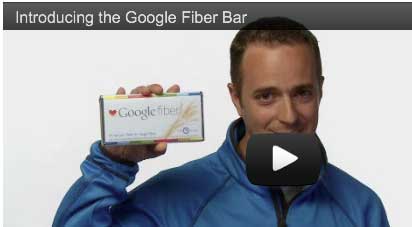
April 1: Here's
Google's new fiber product!
It's "Fiberlicious!"
Meanwhile, on a more serious vein, Google Hits a "Home Run" -
Google has posted information on its installations in Kansas
City for its gigabit FTTH project. They will use a "home run"
architecture with every home connected by fiber directly to a
Google fiber hut that is directly connected to an Internet
backbone. This provides higher capacity for each home and
symmetric speeds - upload and download speeds will be the same.
You
can read details here.
And IGI Group has just published a marketing report: "Google-
A Telecom Threat?"
WantTo Know Where Submarine Fiber Optic Cables Run?
There
is a good map online by TeleGeography you can access here.
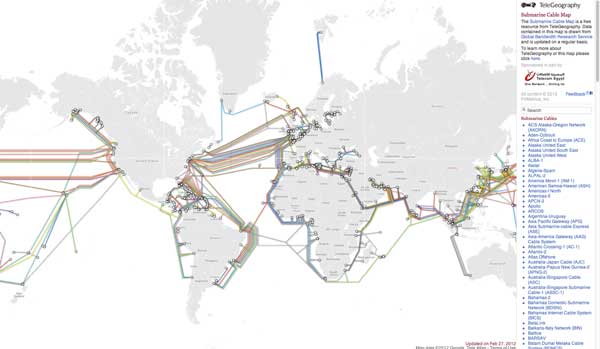
Permits
For Fiber Optic Broadband Projects
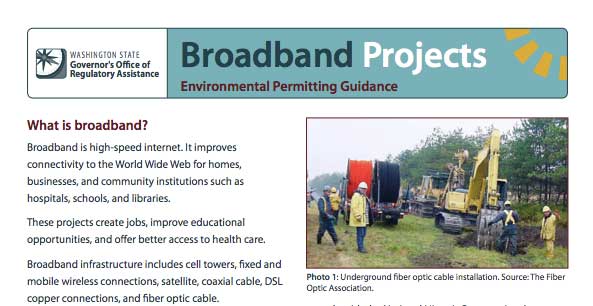
In our design curriculum, one item we warn network designers about
is getting the appropriate permits. The state of Washington, USA,
contacted FOA about a online document they were creating for
contractors and project managers in their state planning broadband
fiber projects which would provide assistance in determining what
environmental permits were needed and where to go get more
information on the permits required. Even if you are not planning
projects in Washington, this is a good document to read to help
understand the permit processes.
Download
the PDF here.
FOA Standards:
FOA has joined the American National Standards Institute (ANSI) to
be able to keep up to date on more standards activities. ANSI is
certainly a diverse organization. In March, when FOA joined ANSI,
the
list of new ANSI members included NASDAQ, Bonneville Power
Administration and Broward (FL) County Sherriff Office Crime Lab!
FOA now offers standards for testing the installed fiber optic
cable plant, patchcords and cable, optical power from transmitters
or at receivers and OTDR testing. Look for the "1
PageStandard" web page and in the FOA Online Reference
Guide.
Go to the FOA
"1
Page Standards"
Free For FOA Members: NECA/FOA 301 Fiber
Optic Installation Standard
Because of its importance to users, contractors and installers of
fiber optic networks, The FOA and NECA have agreed to make the NECA/FOA
301 Fiber Optic Installation Standard available free to FOA
members. It's specifically written to be used in contracts to
define "installation in a neat and workmanlike
manner." FOA
members can go here for instructions on how to download your
free copy.
Two New Fiber U Online Self-Study Programs: Design and FTTx -
coming soon: Testing
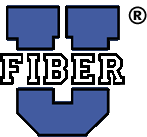
FOA has added two new free online self-study programs to our Fiber
U web-based training site. The new programs cover topics that have
been requested often: "Fiber Optic Network Design" and "FTTx." The
Design course leads you through lessons on fiber optic network
design and planning, then concludes with several online design
exercises to test your understanding. The FTTx course has lesson
plans covering what the "x" in FTTx means, network architectures,
installation and testing, then concludes with a design exercise.
Both use the FOA Online Guide or our textbooks and our YouTube
videos as study materials. If you are interested in the FOA
Specialist Certifications in Design (CFOS/D) or FTTx (CFOS/H),
these are excellent study guides. See
Fiber U for links to the new courses.
We are considering using these self-study courses as part of
online instructor-led courses using Linked-In. We have a new
LinkedIn group, "Fiber Optic Training" (see below) which will be
used for this. Join now for these courses.
FOA Starts New
LinkedIn Group On Fiber Optic Training

FOA has started a new LinkedIn group called "Fiber Optic
Training" dedicated to discussions on fiber optic training.
Anyone can join our new Linked In fiber optic training group. We're
experimenting on teaching instructor-led online courses on
LinkedIn - watch for announcements on the FOA LinkedIn group
and Fiber Optic Training Group. Take
a look and join the group.
2012: The Year of The OTDR
Most of the technical and
testing questions we get here at FOA involve misunderstanding of
OTDR testing. A number of FOA master instructors have suggested
we focus on OTDR training, both in our schools and online, to
minimize the problems, so we have declared 2012 "The Year of The
OTDR." Look for special articles, a new "1pStandard" and
other information that will make these instruments less
enigmatic!
What A FOA Instructor Said:
"So you've had discussions about making 2012 "The Year Of The
OTDR" for training. I couldn't agree more. So many clients,
contractors and sales people we meet have so little knowledge
about OTDR that it's astounding. ... OTDRs are still subject to
interpretation, user error and (in some cases) dead zones that can
still effect the results. Everyone we teach is initially
overwhelmed and looking for "E-Z OTDR" that is fully
automated...!"
What An OTDR Can Tell You About Your Fiber
FOA Master Instructor Terry O'Malley has been creating some
really useful data on OTDRs. He knows OTDRs - he created AT&Ts
training program and taught it for years. Here is some data he
created to show what traces look like for different fiber ends.
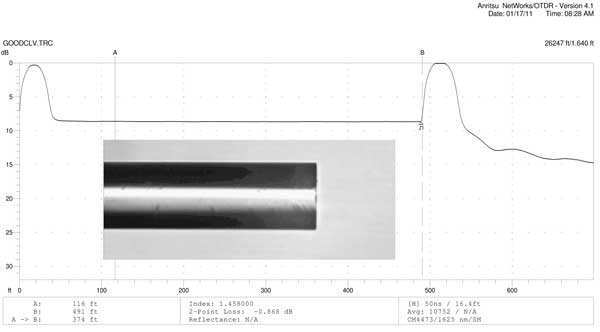
Notice how big the reflectance peak is on the end of the
fiber? Now look at this one:
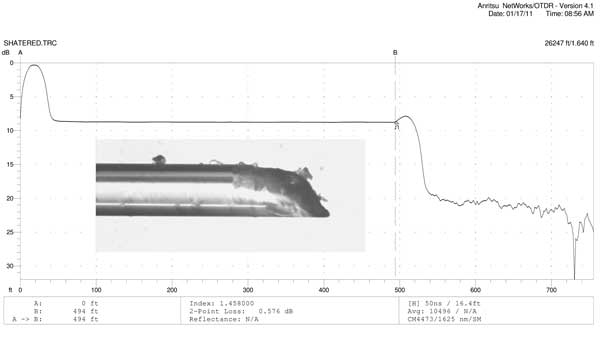
The OTDR can tell you a lot about the end of the fiber. The
reflection on the end of the cable depends on the end of the
fiber. If it’s broken and ragged, you will see practically no
reflection, but a perfectly cleaved fiber will show a giant
reflection peak. Note how the cleaved fiber has a high
reflectance, reaching saturation on the OTDR trace while the
broken trace shows only a small reflectance.
How is this useful? It helps locating breaks, which are usually
broken fibers and determining if the end is a PC connector, which
has high reflectance unless it's connected to another connector.
But what happens with a APC connector? Those are designed to
minimize reflectance so they show little if any reflectance peak.
(Photos from FOA's OTDR
FAQs.)
Three Good Practice Tools For
OTDRs, All Free
You may already know that
the FOA has a free OTDR Simulator you can download from our
website (go
here for directions) that allows you to practice using an
OTDR on your PC, seeing the effects of changing setup parameters
and analyzing dozens of real world traces. But here are two more
tools that can be good for practice.
AFS OTDR Online Demo
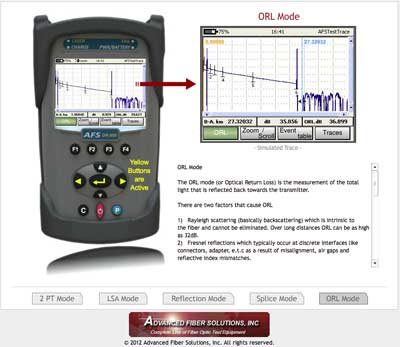
AFS has an online
interactive demo of their new OTDR that allows you to see how an
OTDR makes measurements. You use the yellow buttons in the center
of the OTDR to set the markers to make measurements. Very well
done. Go to http://www.afsi.us/otdr/otdr_mode.php
for the demo.
"Fiberizer" APP Reads, Analyzes OTDR Traces
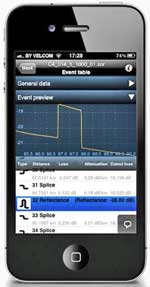
Fiberizer is a iPhone/iPad APP that reads industry-standard
".sor" format files and allows trace analysis on your iPhone
or iPad. An android version is in the works too. Read
more about Fiberizer. And
here are more directions on its use.
OTDR Tip Of The Month:
- Last
Month: What Does A PON Network Look Like On An OTDR?
Many of the technical questions we get here at the FOA deal
with OTDRs and many are problems caused by untrained operators
expecting the OTDR to do the trace interpretation for them. That
is almost always a recipe for disaster! If you are going to use
an OTDR, learn how to use it first. Start with the new Fiber U
OTDR self study course, "Understanding
OTDRs". You can also download the Free
FOA OTDR Simulator to practice analyzing traces.
Free FOA iPad App Calculates Loss
Budget
The FOA has just released its second APP for the
iPad/iPhone/iPod Touch, a free "loss budget
calculator," FOA LossCalc.
FOA LossCalc
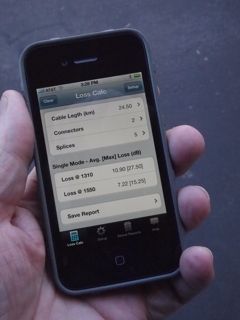
FOA LossCalc estimates the optical loss of a fiber optic
link. This will save time for the installer of a fiber optic
link needing to know whether test results are reasonable
and/or make a "pass/fail" determination. It can also help
the designer of a link to determine if communications
equipment will operate over this link.
By choosing the type of link (singlemode or
multimode) and specifying the length of the fiber and
numbers of connections and splices, it will calculate the
end to end loss of the link. The app has default
specifications for singlemode and multimode links or the
user may create custom setups with specifications
appropriate for any application.
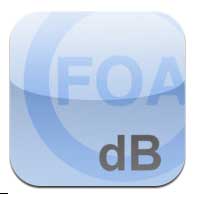 http://itunes.apple.com/us/app/foa-losscalc/id476262894?mt=8&ls=1
http://itunes.apple.com/us/app/foa-losscalc/id476262894?mt=8&ls=1
More New Lectures on 
10 new lectures on premises cabling have been
added to the FOA YouTube channel along with lectures on
fiber to the home - FTTx - and Loss budgets, making 26 fiber
optic lectures total.
Here is a list of the current
lectures (plus there are 28 hands-on videos too!).
We're looking for ideas for topics for future lectures. Send
your ideas to <info@thefoa.org>.
Events of Interest

FOLS Webinar
LAN Standards, News & Trends:
2012 Update
Presented by Pete Pondillo, Standards Chair, TIA's Fiber
Optics LAN Section
Available
Online, Register Here
FIBERFEST - JUNE 13, 2012 - FOA
scheduled to be at FiberFest!

Fiberfest is the one day conference/trade show run by the New
England Fiberoptic Council. This year the event will be colocated
with a FTTH Council meeting in Boston. Watch for details here or
on the NEFC
website.
Exfo Seminars: Eliminating
Guesswork in Next-Gen Fiber Testing
Join EXFO's experts for this half-day seminar dedicated to fiber
testing in testing for metro, PON and cell backhaul networks, as
well as smart grids.
Monday, April 23 - Los Angeles
Tuesday, April 24 - San Diego
Wednesday, April 25 - Phoenix
Click
here to register.
AFL to Host "Traveling" Advanced Splicing Seminars
AFL has launched advanced splicing seminars intended for
engineers and professionals, as well as university students,
engaged in fiber optic activities involving non-standard and
specialty fusion splicing activities. Typical applications for
these advanced splicing needs are often in the Medical, Oil and
Gas, Fiber Lasers, Optical Manufacturing, and Aerospace markets.
These seminars will cover a wide range of applications and
solutions for difficult and challenging applications using
advanced fusion splicing platforms.
- Seminars will be held in around the US and
Canada.
- There is no charge for attending; however AFL will be
conducting pre-registration in order to ensure availability
of a proper facility depending upon the number of
attendees.
- Details on the seminar, a current schedule and signup
form are at http://www.stateofthearc.com/seminars/signup.html
Free Corning "See the Light" Seminars
Corning Cable Systems' See the Light team is coming to a city
near you! Receive Free fiber optic training on a variety
of topics including Termination Technology, Testing and Trouble
Shooting, Fusion Splicing, and Preterminated Solutions. These
interactive three-hour sessions provide students with a
comprehensive overview of the latest technology. Fiber optic
BICSI (CEC) credits apply (3).
Here
is the current information and schedule.
JDSU Testing Webinars
You are invited to join JDSU for a complimentary series of
educational webinars in early 2012. Each webinar, presented by a
JDSU subject matter expert, occurs on the same day and time of
the week and will last approximately one hour, including
Q&A.
Go
here to see the seminars offered and dates. IMPORTANT:
use registration password: FONA1.
Don't forget to download your copies
of the JDSU Testing Textbooks.
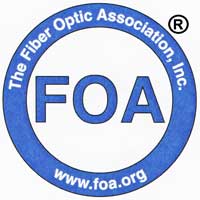 What's
New @ FOA What's
New @ FOA
FOA Standards
For Contractors, Designers, Installers and Users
Read
more about them here. And above.
Go to the FOA
"1
Page Standards"
FOA Certifications Recognized By US Department of Labor
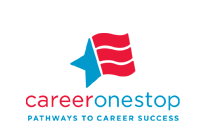
All
FOA
Certifications have now been recognized by the US
Department of Labor. The DoL reviews certifications and
how they relate to job opportunities and training. The DoL
Career OneStop website helps individuals explore
career opportunities to make informed employment and
education choices. The Web site features user-friendly
occupation and industry information, salary data, career
videos, education resources, self-assessment tools,
career exploration assistance, and other resources that
support talent development in today's fast-paced global
marketplace.
FOA
Certifications Listed By US Department of Labor - Career OneStop
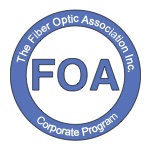 New
Corporate Memberships New
Corporate Memberships
FOA is now offering corporate memberships to companies
involved in fiber optics as manufacturers, contractors,
installers, etc. Read
more. Among other benefits, Corporate Membership gives
companies access to special FOA materials for educating
customers and employees.

Two New Free Fiber U Self-Study
Programs on Design and FTTx
There are two new free online self-study
programs on Fiber
U. Fiber Optic Network Design is for those
interested in learning more about how ot design fiber optic
networks or studying for the CFOS/D certification. FTTx is for
those wanting to know more about fiber to the "x" - curb, home,
wireless, etc. - or studying for the CFOS/H
certification.
Got to Fiber
U for more information.
FOA Certification On Outside Plant Fiber Optics
The FOA CFospT outside plant certification focuses on
OSP fiber optic network design, installation and maintenance. A
CFospT certified tech must know the ways that fiber is used in
the OSP, how it is installed, tested and maintained. While a
CFOT might only have a basic knowledge of fusion splicing and
OTDR testing, for example, a CFospT will be knowledgeable and
skillful in those areas - and more. Reference materials for the
new CFospT are the printed textbook, the FOA
Reference Guide to Outside Plant Fiber Optics
(right) as well as eBooks from Amazon for the Kindle or Apple
for the iPad/iPod/iPhone and the OSP
reference section of the FOA Online Reference Guide which
now includes a self-study
guide to the CFospT exam.
More information on the FOA Outside
Plant Fiber Optic Technician (CFospT) certification.
- Reference Books for FOA
Certifications are now available on Kindle and
iPad/iPhone
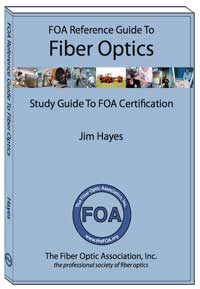
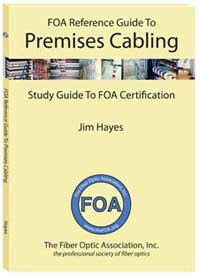
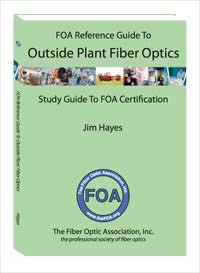
We have created three new FOA books to be used in training for
FOA certifications and as reference books for contractors,
installers and end users of fiber optics. These books have
full curriculum support, including free curriculum materials
for teaching FOA certification courses. Because we are
self-publishing these books using more modern "publish on
demand" technology, they are easier to keep up to date, easier
to buy and much, MUCH cheaper!
All are now available in print and electronically in Kindle
and Apple iBook versions. The basic fiber optic book is also
available as a self-study program in an Apple APP for
iPad/iPhone/iPod.
Details on the new book each of the new books are at the book
pages linked to the photos above.
FOA iPad Apps
The FOA has just released its second APP for the iPad, a
free "loss budget calculator," FOA LossCalc.
FOA LossCalc
 FOA
LossCalc
estimates the optical loss of a fiber optic link. This will
save time for the installer of a fiber optic link needing to
know whether test results are reasonable and/or make a
"pass/fail" determination. It can also help the designer of
a link to determine if communications equipment will operate
over this link. FOA
LossCalc
estimates the optical loss of a fiber optic link. This will
save time for the installer of a fiber optic link needing to
know whether test results are reasonable and/or make a
"pass/fail" determination. It can also help the designer of
a link to determine if communications equipment will operate
over this link.
By choosing the type of link (singlemode or multimode) and
specifying the length of the fiber and numbers of
connections and splices, it will calculate the end to end
loss of the link. The app has default specifications for
singlemode and multimode links or the user may create custom
setups with specifications appropriate for any application.
http://itunes.apple.com/us/app/foa-losscalc/id476262894?mt=8&ls=1
Self -Study in Fiber Optics
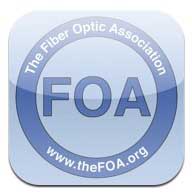 Our
first app is a self-study version of the FOA Reference Guide
to Fiber Optics. The FOA APP builds on the FOA basic fiber
optic textbook to create an interactive learning environment
that builds on the iBook electronic version of the book to
add a guide to use for self-study and real-time testing that
provides feedback on what you have learned and correct
answers to questions answered incorrectly. Our
first app is a self-study version of the FOA Reference Guide
to Fiber Optics. The FOA APP builds on the FOA basic fiber
optic textbook to create an interactive learning environment
that builds on the iBook electronic version of the book to
add a guide to use for self-study and real-time testing that
provides feedback on what you have learned and correct
answers to questions answered incorrectly.
The FOA APP is priced at only $9.99, same as the iBook, so
the self-study program is free. Download it from the Apple
APP Store with your iPad or iTunes.
http://itunes.apple.com/us/app/foa-guide/id434354283?mt=8&ign-mpt=uo%3D4
NECA/FOA 301
Installation Updated
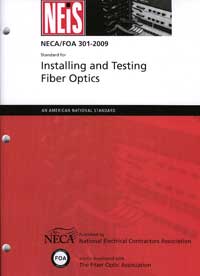
Standards cover components and systems and how to
test them, but rarely get into installation issues. The FOA NECA
301 standard which covers installation of optical fiber systems
has been revised for the second time, adding considerable new
materials. This standard is derived from FOA educational
material put in standards form and approved by ANSI as an
American National Standard. It's specifically written to be used
in contracts to define "installation in a neat and
workmanlike manner." The standard is available from NECA.
FOA members can go here
for instructions on how to download your free copy.

2 New Lectures: About The FOA and FOA
Standards, plus 26 Fiber Optic Lectures, 10 Premises Cabling
Lectures Plus 28 More Hands-On Videos
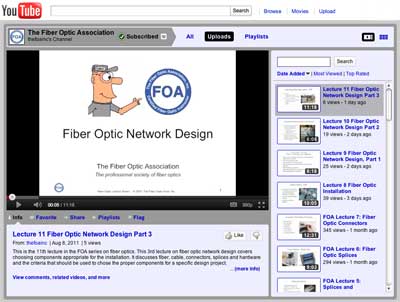
Below is a list of the current lectures (plus there are
28 hands-on videos too!). We're looking for ideas for topics for
future lectures. Send your ideas to <info@thefoa.org>.
New: Ten More YouTube Videos – Lectures On Premises Cabling
The FOA has added 10 more videos to our YouTube Channel,
thefoainc. These are an introduction to premises cabling,
covering applications, types of cabling, standards and
installation practices for copper (UTP and coax), fiber and
wireless. Like our lecture series on fiber optics, these provide
a comprehensive introduction to the subject in short videos,
typically 5-10 minutes in length, on each subject. Watch for
more.
Here is a list of the Lectures now on YouTube.
View
the FOA YouTube video Lectures.
What's New
in the FOA Online Fiber Optic Reference Guide
We have been updating
the Online Reference Guide to keep up with changes in the
industry and adding lots of new pages of technical
information.
FTTx
and Design
Pages Updated
As we developed the new Fiber U self-study courses,
we updated the FTTx and Design pages and added a FTTx
installation section.
OTDR FAQs
Including FOA Master Instructor Terry O'Malley's tests
on what the end of a fiber trace looks like with broken
and cleaved fibers.
Frequently
Asked Questions On OTDRS And Hints On Their Use
Testing FTTH
Basic
guidelines for testing FTTH PON networks
Measuring Reflectance or Return Loss
It
can be important but it's not so easy to test.
Fiber Optic and Premises Cabling Project Paperwork
Covering
what are SOW, RFPs and RFQs and how they are created
for a project.
Effects of Alignment and Fiber Geometry on Fiber Optic
Connector Loss
With
all the controversy about connector loss due to modal
distribution, we sometimes forget the effects of
component variations.
Fiber Optics For Wireless Networks
How
wireless is not wireless - it needs fiber.
Learn More About OTDRs - Download
a Free OTDR Simulator
More and more installers are being asked for OTDR testing but
using these instruments is not easy. They are hard to set up
properly and complicated to interpret the traces. Using the
autotest function can lead to disastrous results! The FOA has a
good tutorial on OTDRs on our Online Reference Guide and we
added a free download of an OTDR
simulator to the OTDR
section so you can learn how to use an OTDR on your PC.
More New Info:
Links to manufacturers
and distributors of fiber optic lighting products.
The
FOA Online Fiber Optic Reference Guide
has become very popular - perhaps the most popular technical
website ever, typically with over 360,000 users downloading
about 1.75 million pages in 2011! We continue updating
materials regularly, keeping it as up to date as possible.
Find What You Want Using "Google
Custom Search
 There's
so
much information on the FOA Tech Topics and
Online Fiber Optic Reference Guide that even a
well-organized Table of Contents isn't enough and when the
material is always changing, an index is impossible to maintain.
So the FOA is using the latest technology in search, Google
Custom Search, which will allow you to search just the
FOA Tech Topics and Online Fiber
Optic Reference Guide for any topic you want to find more
about. Try
it! There's
so
much information on the FOA Tech Topics and
Online Fiber Optic Reference Guide that even a
well-organized Table of Contents isn't enough and when the
material is always changing, an index is impossible to maintain.
So the FOA is using the latest technology in search, Google
Custom Search, which will allow you to search just the
FOA Tech Topics and Online Fiber
Optic Reference Guide for any topic you want to find more
about. Try
it!
Go
to
The
FOA Online Fiber Optic Reference Guide.
School News
Students:
Smart Grid Program Places Coop Student
Tom Collins, instructor at Gateway Community College in
Cincinnati, and FOA Board Member, reports on their "Smart Grid"
program that includes FOA curriculum and certifications: "We
have placed our first Smart Grid Coop student with DUKE in Cincy.
They wanted a lineman ( Utility tech) with Fiber/communication
training. Our CPCT program is so critical as part of their
skills set."
FOA Training Leads To Work
Cary Lee Pabayo got his CFOT from Wallace Allen who moved from New
York City to teach in the Phillipines. Cary was trained by Nexus-Net,
FOA school # 742 on the campus of the Asian College of Technology.
Now he's installing fiber for Transfield Services and building the
broadband network in NZ.

New Schools
The FOA welcomes the newest additions to our listing of
FOA-Approved
Training Organizations:
Alliant Global Training Center, FOA-Approved School #326
Madison Area Technical College, FOA-Approved
School #643
IBEW Local 193, FOA Approved-School #642
Find
a listing of all the FOA-Approved schools here.
It's
Now A Lot Easier To Find A FOA-Approved Training
Organization
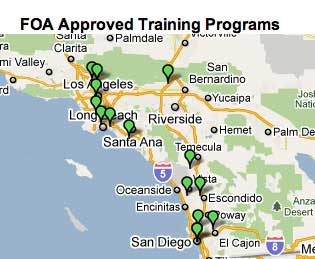
Most phone calls we get regarding finding a
FOA-Approved training organization want to know two things:
what school is closest to me or what school offers the
certifications I need. That can be difficult, since the FOA
has almost 200 training organizations we have approved
worldwide!
We've been looking at ways to make it easier, and we think
we've got a good solution. In fact we have two solutions.
First we have added a sortable
table of all the FOA-Approved schools.
You can also use our FOA
Google Map Application to find FOA-Approved schools.
Here are links to the sortable
table of all the FOA-Approved schools and
FOA
Google Map.
What Should A Fiber Optics
or Cabling Tech Know and What Skills Do They Need?
The FOA has been updating its lists of KSAs
(Knowledge, Skills, Abilities) for fiber and cabling
techs. The updated list is now on the website for your
information and comments - as fiber and cabling KSAs
evolve as new technologies develop.
KSAs for fiber
and cabling techs.
Good
Question!
Tech Questions/Comments Worth Repeating
Tech Hint: Did
You Know You Have A Fiber Optic Tester In Your Pocket?
Yes! The camera in your cell phone is sensitive
to infrared light - lots more than your eye - and can
detect light in an optical fiber or from a
transmitter. Chris Hillyer,CFOT/CFOS/I,
Master
Instructor, Northern California Sound &
Communication JATC sent us some photos showing how this
works. See
below or the video
now on YouTube. Update:
You should check out your old cell phones before you
recycle them. We've found older models use sensors
which are better at infrared than the newer ones which
take better pictures. This is a good use for your old
cell phones hiding in the drawer!
More on Loss Budgets
(4/12)
Q: We
manufacture cables for seismic industry which contains
fiber optics. I have some questions after checking your
loss budget document at http://www.thefoa.org/tech/lossbudg.htm.
a-If we want to establish the specs for max allowed
attenuation for a cable containing 1 connector at each
end (meaning the cable has 2 connectors); is it correct
to calculate it this way: 2 x (0.75 db “TIA-568
max) + fiber loss along the length = our loss budget ?
b-What about the connectors of the optical power meter
used for measuring (the ones we mate with each connector
at end to transmit/receive the light)? Should I add
their connector loss in the budget or I assume that the
connector mate loss = max loss between one of both
connectors (assuming the one at the cable has higher
loss) for each end?
A: Let's start
with question "b", testing. For reference, I'm
going to use the new FOA standard for testing the cable
plant: FOA
Standard FOA-1
I am assuming the connectors on the cable are compatible
with the meter, e.g. some version of the SC/ST/FC family
with 2.5 mm ferrules and you have some compatible launch
and receive cables that have been tested and are known
good.
When you do a reference calibration in the one cable
reference method, you attach the launch cable to the
source (leave it attached for the duration of the
testing) and the other end to the meter input to do the
"0 dB" calibration. Most meters have an adapter that
screws on top of the actual detector of the meter so the
end of the fiber faces the detector. This interface is
not without some loss, but it is consistent in the
coupling of the power from the fiber to the detector of
the meter, so it is a constant in the measurement.
Now we know how much power is exiting the fiber of the
launch cable. To test a cable, we attach the cable we
want to test to the launch cable. That connection has
loss that depends on the quality of the connectors on
each cable and the alignment precision of the mating
adapter for the connectors.
If we attached the other end of the cable we are testing
to the meter now, we would measure the loss of the
connection to the launch cable and the loss due to the
attenuation of the fiber in the cable. Since the
connector mated to the meter has the same interface as
the reference cable when we calibrated "0 dB"
there is no loss added in this connection. We use this
test for patchcords since it allows us to test each
connector independently by reversing the cable and thus
we can identify if we have one bad connector.
Completed cable assemblies are usually tested double
ended, so on the opposite end from the launch, we attach
a receive cable. The connection to the cable under test
is added to the loss we measure and the connection to
the meter is the same as for all other measurements so
it is not included.
Thus the loss budget adds the connections on each end of
the cable to the fiber loss since that is what is
measured in this test.
Now we did this test with what we call a "1 cable
reference" but there are options for 2 or three cable
references. The standard linked above shows why you
might use a 2 or 3 cable reference, it's a matter of the
connectors on the cable and the meter and how they can
be mated. What confuses people is what you are actually
measuring with the 2 or 3 cable reference, since
connections are included in the setting of the "0
dB" reference. We have a web page that explains the
math:
http://www.thefoa.org/tech/ref/testing/5ways/lossmath.html
In our loss budget calculations, we always include the
loss of the connectors on each end since most tests are
done with a 1 cable reference. If you use a two cable
reference, the loss is reduced by the amount of loss in
the connection(s) during the setting of the 0 dB
reference, plus the measurement uncertainty is increased
due to the uncertainty of the loss included in the
reference. We address the measurement uncertainty here:
http://www.thefoa.org/tech/ref/testing/5ways/fiveways.html
Now question "a": The answer is "yes" with a caveat.
That is how you calculate the loss budget. Most
connectors do not have 0.75 dB loss! That number has
been used in TIA and ISO/IEC standards for many years.
It was created by manufacturers as a worst case value
for them to use so that all types of connectors would
meet the standards. In fact, the more typical values for
loss are ~0.3 dB for adhesive polish connectors,
~0.5-0.75 dB for prepolished/splice connectors and ~0.75
dB or more for multifiber connectors.
So while 0.75 dB is in the standard and widely used, you
may want to use a lower value more representative of the
manufacturing process.
Burying Fiber Ducts
Below Frost Line (3/12)
Q: Should fiber ducts in northern regions be
laid below frost line. Frost line in some areas of
Canada is typically 8 feet.
A: Normally
telecommunication conduit should be place below frost
line when ever possible. Cost is always a factor, in
most cases frost line does not exceed 36" (1 meter
aprox). Northern Canada is an exception. Depending on
the strength of the conduit/cables to resist the
crushing force of ice frozen in place around cables (see
manufacturer). Ice has been know separate conduits from
itself, frost has crush conduits/cables. The following
designs have been used:
1) Use schedule 80 conduit/ GIP conduit (threaded pipe).
2) Design each conduit section so that it will drain
down hill.
3) Keep water out off handholes/manholes. This can be
very difficult & costly.
4) Ensure that cables can maintain frost crushing (see
manufacturer).
Companies like Bell /AT&T have been placing conduit
below or at 3' to 5' in Canada.
Companies like CATV have been placing conduit below or
at 2' to 4' in Canada.
In the US most conduits are placed 24" to 60" for
communication.
Each situation will need to be reviewed on a case by
case bases.
Municipal Fiber Network
Advice (2/12)
Q: I am charged with researching a municipal
requirement to install fiber optic infrastructure in new
development--this could either be for active development
or dark fiber for future connection. Any pointers
as to where to look? Have any communities done
this well.... done this poorly.... have good
examples of policy, legal code or standards?
A: Municipal
networks are becoming very common. The best example I
know is Santa Monica, CA Citynet http://www.smgov.net/departments/isd/smcitynet.aspx
and we've interviewed them on the project.
Santa Monica built a citywide network to combine
connections to all the city offices, public safety
offices, libraries, etc. plus added numerous CCTV
surveillance cameras, smart traffic signals and muni
WiFi. They installed lots of fiber - fiber is cheap but
installation can be costly, so they built a big network
with lots of dark fiber in the beginning. Then they
leased fiber to the local CATV company, Verizon for FiOS
fiber to the home, and connected up dozens of tech
companies to high speed Internet access (Google, Yahoo
and dozens of movie production houses are located in
Santa Monica.)
The really good deal was it paid for itself. Federal
money helped with the initial installation
(DoTransportation, DoEducation, Homeland Security) and
leased fiber keeps the income coming.
As a big college town already involved with "Gig
U" (http://www.gig-u.org/),
you should contact the people at the University to see
what they have planned that may be able to be combined
with your work.
I suspect that every town has its own issues with
policy, codes and standards. We've discussed some of the
issues with other towns and one thing that comes up
regularly is that at a minimum, the town should own the
conduits even if the fiber is private. If a private
contractor digs up the streets to bury cables they
should be required to install many conduits for whenever
another company wants to pull cable, the conduit is
ready and no digging will be necessary. We also suggest
talking to the local telephone and CATV companies. In
the past, many have fought muni fiber but now many
cooperate with the city and lease fiber from them.
Help On Termination
2/12
Q: I'm working as an user and sometime I
install connectors on fibers. Most of the time I work
with ST connectors. Do you have a small guide how to
prepare, and polish the fibers ? Is it possible to use
ST single mode connector on Multimode fiber and
viceversa ?
A: We have
several links that help you:
YouTube Videos:http://www.youtube.com/playlist?list=PL21F27A040DFAA6E5&feature=plcp
Tutorial: http://www.thefoa.org/tech/ref/termination/Term/Term.htm
Step-By Step Virtual Hands-on Termination:
Epoxy/Polish, Anaerobic, Hot Melt
Singlemode fiber termination, Hands-on SM termination
Even more from the FOA Online Reference Guide: http://www.thefoa.org/tech/ref/contents.html#Components
Singlemode connectors have tighter tolerances and a
slightly smaller hole in the ferrule. Generally
speaking, you can use SM connectors on MM fiber, except
when the fiber diameter is on the high side of tolerance
but you should never use MM connectors on SM fiber as
the fit will be sloppy and the resulting core offset
causes high loss.
Removing Unused Cables
2/12
Q: Can you point me in the direction of
information on how to properly and safely remove 50
Micron Multi-mode Fibre Optic Cable from a data
center? My company would like to remove their old
FOC when they upgrade to 10g cable fibre and were
considering cutting the LC connectors off the cables to
make it easier to pull through the rats nest of cables
under the floor. Is this a safe method?
A: There is not
standard way to remove cables, as it will depend on the
installation. Cables in underfloor (or overhead) trays
tend to be enmeshed in other cables unless they are in
separate ducts. Under any circumstances, the best way to
remove them is to cut off connectors, locate the cables
and cut into lengths that are easily removed (just make
sure you are cutting the right cables - a installer
doing this with some cables in Newark, NJ once cut the
wrong cable and put Wall St. out of business for a
day!). Once they are cut into short lengths, it should
be easy to remove them.
After removal, the cable can be recycled for the plastic
- connectors are trash. Or if they are long enough, I
may know some schools who would like them for their
hands-on labs!
Higher Loss At Long
Wavelengths? 1/12
Q: I have a tech
in the field that has installed a piece of single mode
fiber approx. 650’ long. He is testing it with a source
and meter. The fiber is passing the 1310 loss test but
failing the 1550 test. What could be causing this? He
has put new ends on the fiber already and is getting the
same results.
A: This sounds
like a classic problem of cable stress. Singlemode fiber
is much more sensitive to bending stress losses at
1550nm than 1310nm. If there is a stressed area in the
cable installation, it's easy to get >3dB loss from a
tight bend or kink, even near the connectors. There
should be no difference with the connectors themselves.
Telcos test links at 1625nm for stress testing.
Followup: The
tech went back to the job site with an OTDR and found
there was a spike in the reading about 120’ from one end
which is where there is a pull box up in the ceiling.
Fiber
Cleaning
This is a topic we keep reminding everybody about, and
here is why:
From a contrator in the Middle East:
Here some samples of the connectors for SM fiber already
installed in the system we were testing.

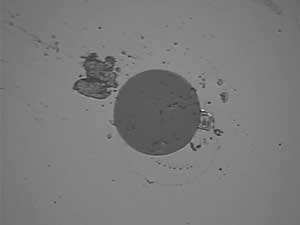
As you can see, the dirt is
large compared to the size of the fiber (dark gray), and the
core (not visible here) is only 9/125 of the overall
diameter of the fiber! More
on cleaning. See Product
News below for links to vendors of fiber cleaning products.
See news about Fiber
Optic Cleaning Videos on YouTube by ITW
Chemtronics below.
Measurement Uncertainty: Everyone testing
fiber optics should understand that every
measurement has some uncertainty - whether you are
measuring loss, length, wavelength, power, etc. Knowing
that uncertainty is very important to
interpreting the measurement. It's worthwhile to
read and understand the issue of measurement
accuracy covered in this
page of the FOA Online Fiber Optic Reference
Guide.
Worth
Reading
or Watching:
What's
ahead for multimode fiber communication systems?
By Gastón E. Tudury, Ph.D., and Al Brunsting, Ph.D.,
Panduit
With networks like Ethernet moving to 40 and 100 Gb/s,
current multimode fiber has been forced to a parallel optics
solution, not considered acceptable by some users like Google, due
to the masses of fiber needed for data centers. Rather than go to
a singlemode WDM solution, these two suggest we should look at
redesigning MM fiber, cutting the NA for higher bandwidth and
maybe tweaking the VCSELs too.
Lightwave.
Choosing
the right connector: APC vs. UPC
An
interesting article from ADC on the differences in APC and UPC
connectors makes the choice easier.
Read
more.
Benchmarking Fusion Splicing And Selecting
Singlemode Fiber
We've been asked many times "How long
does it take to splice a cable?" It's not a simple answer as
it varies with the number of fibers in the cable and the
work setup, including whether one or two techs are working
at a job site. FOA Master Instructor Joe Botha of Triple
Play in South Africa did his own analysis based on decades
of experience both splicing cables and teaching others how
to do it properly. This is one of the best analyses we have
seen because Joe includes prep times as well as splicing
times and differentiates between one tech and two techs
working together. He adds some other tips on fusion splicing
too. This should be mandatory reading for every tech and
given to every student! Here
is Joe's splicing analysis.
Joe also has an excellent writeup on how to choose
singlemode fiber that helps understanding the different
types of G.6xx fiber. Read
it here.
Videos
on Firestopping: These free videos from UL and the
International Firestop Council are good tutorials on
firestopping. Go
here to view the videos.
Micro-Trenching,
Cable Removal (3/12)
Nano-Trench
offers products for micro (or I guess they call it
nano-) trenching and their
website is very informative. They also have Kabel-X,
a method of extracting copper cables from old conduit.
Both websites are informative and interesting. Watch
this video on the cable removal process!
Free - Mike
Holt's Explanation Of The US National Electrical Code
(NEC) For Communications Cables
Mike Holt is the acknowledged expert of the US
National Electrical Code (NEC). His books and seminars are
highly praised for their ability to make a very complicated
standard (that is in fact Code - law - in most areas of the
US) easily understood. Part of the appeal is Mike's great
drawings that make understanding so much easier. Mike makes
Chapter 8 of his book available free. It covers
communications cables, telephones, LANs, CATV and CCTV, for
premises applications. Even if you live in a region or
country where the NEC is not the law, you may find this
interesting.
Download
Mike's Chapter Here.
Fiber Optic Crossword
Puzzles For Entertainment And As A CFOT Certification Study
Aid (2/12)
Pearson
Technologies Inc., a 32-year fiber optic training, technical
and marketing consulting firm, announces availability of a
free training and certification tool. This tool is a free set
of crossword puzzles on the terms of fiber optic installation
and products. This set assists those studying fiber optic
installation or planning to take the Fiber Optic Association
(FOA) Certified Fiber Optic Technician (CFOT) certification
examination. The four puzzles are for: light and fiber terms,
cable terms, connector and splice terms, optoelectronics and
testing terms.
The
puzzles can be viewed and printed from: http://www.ptnowire.com/resources.htm
or http://www.ptnowire.com/CFOT-Puzzles-vb.pdf.
Individuals can receive the answers by email request.
For
additional information, contact Pearson Technologies Inc. at:
4671 Hickory Bend Drive, Acworth, GA 30102, at (770) 490-991,
or via e-mail at fiberguru@ptnowire.com.
New Eric Pearson Books (2/12)
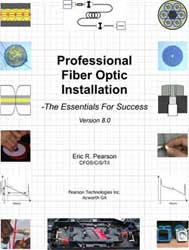
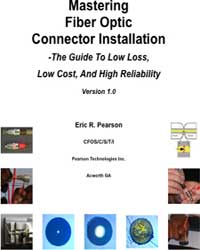
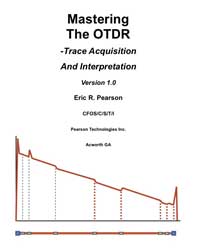
Pearson
Technologies Inc. announces the release of three new books,
Professional Fiber Optic Installation, The Essentials For
Success, Mastering Fiber Optic Connector
Installation and Mastering The OTDR.
Based on 31 years of experience, laboratory testing,
development, and training of more than 8000 installers,
these books is suitable for training, installation,
personnel certification, and reference. Eric's books are
perhaps best described as fiber optic "cookbooks," full of
detailed directions that reflect many years of tesing in his
courses. They are valuable references for the fiber optic
tech.
For additional information. contact Pearson Technologies
Inc., www.ptnowire.com,
fiberguru@ptnowire.com,
770-490-9991
Fiber Optic Cleaning Videos on YouTube
ITW
Chemtronics has three fiber optic cleaning videos
on  covering Dry
Cleaning, Wet-Dry
Method, FiberWash
and Combination
Cleaning. They are good explanations of cleaning
processes - the Wet-Dry is especially interesting.
covering Dry
Cleaning, Wet-Dry
Method, FiberWash
and Combination
Cleaning. They are good explanations of cleaning
processes - the Wet-Dry is especially interesting.
A Documentary Treasure on the
History of the Internet
15 minutes of a rarely-seen
BBC documentary demolish the myth that ARPAnet was inspired
by nuclear war, and explain the far more intriguing truth.
http://www.technologyreview.com/blog/mimssbits/26719/?nlid=4433
Ensuring Distance Accuracy On OTDR Measurements
By
JDSU.
Broadband Properties Webinar
Archives

Lots of interesting webinars, mostly on FTTH. Go
here.
FTTX Networks
An ADC white paper on how they
work and how networks are upgraded to FTTH. http://connectedplanetonline.com/images/CP-ADC3-WhitePaper-v4.pdf.
JDSU Application Note On "Qualifying
FTTH Network before Equipment Installation"
Another great paper from JDSU covering FTTH PON
networks is available for downloading. It gives an overview of
FTTH architecture, cleaning connectors then testing the cable
plant with OTDRs and OLTSs. This paper will help you understand
why OTDRs can be confusing on PONs!
Best Practices For Wireless Backhaul Network Upgrades
Joan Engebretson, Contributing Editor of Connected Planet has
written a very good overview of how fiber is essential to the
operation of cellular wireless systems. Everybody probably knows
that fiber is used to connect towers into the telecom network -
they call it backhaul - but her article also covers the new
appliations to replace bulky, heavy, lossy coax up the
tower to the antennas. http://connectedplanetonline.com/images/CP_ADC2_WhitePaper.pdf.
Fiber
Optic Safety Poster
We've had numerous requests to reprint our guidelines
on
safety when working with fiber optics, so we have created
a "Safety Poster" for you to print and post in your classroom,
worksite, etc. We suggest giving a copy to every student and
installer.
Corning now offers videos on  .
Lots of interesting videos, some technical, some sales, but all
good information. .
Lots of interesting videos, some technical, some sales, but all
good information.
US Conec's videos
on cleaning fibers - show's the results of
proper cleaning.
Webinars of Interest
Broadcast Engineering Magazine - Fiber Optic
Testing
FOA President Jim Hayes presents an overview of
fiber optic testing for all applications. Available on
Demand. Sign
up here.
Multimode Fiber Trends from
TIA's Fiber Optics LAN Section
Ryan Chappell, Draka Communications, looks at the evolution of
multimode fiber, examines its current usage and shares
predictionson its future Available on-demand at: http://www.brighttalk.com/webcast/7182/play
OSP Magazine Webinars
OSP Magazine (OSP as in outside plant telco) is now offering
a number of interesting webinars that cover fiber topics,
including network design and specialized components. http://www.ospmag.com/events/web/
Multimode
Fiber Characterization Launch Condition Considerations - new
ap note from JDSU
JDSU Reference Guide to Fiber Optic
Testing – Volume 2 Published
The second volume of the JDSU series on fiber optic testing has
been published. Volume 1 focused on Basic Fiber
testing and Volume 2 is geared toward fiber optic installers,
project managers, telecom technicians and engineers who need to
understand fiber networks. Volume 2 also covers Chromatic
Dispersion, Polarization Mode Dispersion, Attenuation Profile
and Fiber Link and Network Characterization. A 3rd volume, a
glossary of fiber optic terms, is also available for download.
This is a "MUST HAVE" for all fiber optic techs. Download
your free copies here.
We used this book as one of our references in creating a new
page
in the FOA Online Reference Guide on chromatic dispersion (CD)
and polarization-mode dispersion (PMD).
Careers
in Fiber Optics: Brian
Smith.
A 1998 book on fiber optic jobs is a bit dated, but a free
overview is on Google Books and worth a look at it online.
Dirt!
As much as 70% of the problems associated with
deploying fiber to the home result from something as simple as
dirty connectors according to JDSU. Telephony
Online.
US Conec's videos
on cleaning fibers - show's the results of proper
cleaning.
Good Technical Websites
American Polywater (http://www.polywater.com/)
has one of the best technical website for cable installers. Here
is a rundown on some new material on their site.
Cable Installation using "Push" or "Push/Pull"
Polywater's new Pull-Planner™ 3000 Software allows a "pushing
force" variable in pulling tension calculations. Read a
White Paper that quantifies the push contribution and compares
calculation results to field experience. --
http://www.polywater.com/pushing.pdf
Pulling Cable Through Water?
Read a Product Spotlight on Polywater® + Silicone™, Polywater's
new generation underground lubricant. Continued reduction
of friction when pulling through water is only one of the unique
features of this lubricant. --
http://www.polywater.com/NNNBSL.pdf
Check out their website, especially “Videos,” “Engineer’s
Corner” and “Calculators.” http://www.polywater.com/NNNBSL.pdf

" Heard on the Street" is a monthly online newsletter from Frank
Bisbee of Communications Planning Corporation that covers
the telecommunications and cabling businesses. Each month
includes news from manufacturers, trade associations and
professional societies like the FOA. You can read the current
issue and back issues online.

JDSU has announced the See the Light
webinar series, a four-part program designed for anyone
involved in the installation, maintenance, and repair of
fiber optic systems. It begins with fiber inspection and
cleaning and then covers the basics of fiber testing. The
webinar series then continues with the more advanced optical
time-domain reflectometer (OTDR) and fiber local area
network (LAN) testing challenges. More
information on the series.
IGI is offering a series of webinars on topics of
interest to those in the communications industry. You
can join them live ir download from the archives. IGI
WEBINAR ARCHIVES UP AND RUNNING - VISIT TELECOMBRIEFINGS.COM
TO DOWNLOAD!
IGI, a major market research and technology reporting
company (the "Active Optical Cables" below) is
offering a a free one year subscription to one of our
fiber optics newsletters to FOA members. All
they have to do is to send IGI an e-mail stating which
newsletter they would like to get. See http://www.igigroup.com/nl.html
for a listing of IGI Newsletters.
-
- FOA
Tech Topics -
A Fiber Optic Tester In
Your Pocket? (See the video on  )
)
Yes! The camera in
your cell phone is sensitive to infrared light - lots
more than your eye - and can detect light in an optical
fiber or from a transmitter. Chris Hillyer,CFOT/CFOS/I,
Master
Instructor, Northern California Sound &
Communication JATC brought this to our attention.
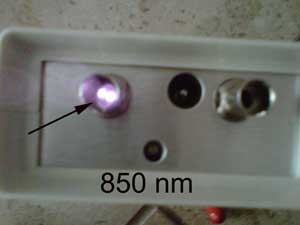
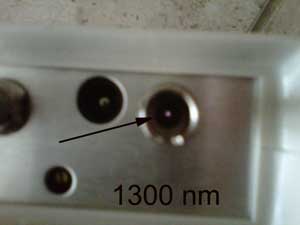
If you have
an old cell phone, try it too. Our experience is that older
cell phone cameras have better sensitivity at IR wavelengths
than newer phones, so you may want to toss that old phone into
the toolbox.
- FOA
Technical Bulletins
- How do you design and manufacture
fiber optic systems? Choose and install one to serve your
communications needs? Troubleshoot problems? The FOA Fiber
Optic Technical Bulletins will provide step-by-step
guidelines to help you. All are PDF files you can
download, print and use.
- Testing
Update
- Are there really 5
different ways to test optical fiber cabling after
installation? Why so many? How do the measurements - and
more importantly the measurement results - differ? What are
the advanteages and disadvantages of each method?
- Why
are there 4 ways (maybe 5) to test fiber optic cables?
- Do
OTDRs and OLTS tests give the same results?
-
- New Tech
Topics
- Industry
standards updated to include international standards
- Updated link
specs for fiber optic networks - now includes
10/40/100G Ethernet.
Product
News
Uraseal FOD-40 Drop Splice
Protection Kit
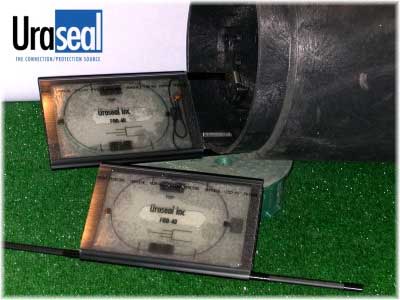
Uraseal has developed a procedure allowing the use of
round cables up to 8mm (5/16") in diameter with the FOD-40
kit. This procedure allows the technician to attach round
cables to the channels in the FOD-40 kit, where the remaining
steps for preparing and filling the kit remain the same.
For more information you can download the FOD-40 splice kit
instruction sheet at this link:
http://www.urasealtraining.com/Instructions/FOD-40rda8.pdf
Videos On Installing Valdor Crimp-On Connectors
Valdor just released these
short SP and ST connector videos demonstrating the simplicity
of field installation.
SP & ST field
installation videos: http://youtu.be/RggqruyagMc
and http://youtu.be/9to5-kxTEPA
Valdor company and product
overview: http://youtu.be/hK-cq2d8ofo
OTDR Software for Standardized Cable Plants
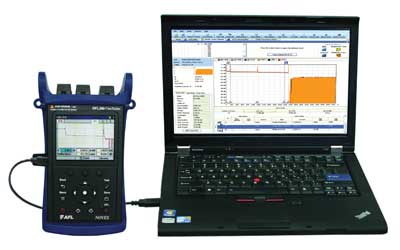
Noyes has introduced new software for their OTDRs called Test
Results Manager which helps viewing and analyzing OTDR traces.
In addition, it can compare results to required performance for
networks like 10G Ethernet and certify the fibers for those
networks. There is an interesting note on standards here. The
standards for the fiber optic cable plant required to support
IEEE 802.3ae 10G Ethernet are specific to the network (see
here for a list of most network fiber cable plant requirements)
and if testing is being done to determine if the cable plant
will support this network, testing must be done to the network
standards not the generic cable plant standards to ensure proper
operation. This is another common misconception of
standards. Read
more on the Noyes TRM(r) software.
Restoration Kits
TriNet Communications offers restoration kits for field
emergencies (e.g. backhoe fade), covering both temporary and
permanent repairs. Kits include cable with a specified number of
fibers, splice cases and mechanical splices. Here are links to
specs on both temporary and permanent repair kits.
Temporary
Restoration Kits
Permanent
Restoration Kits
Handheld OTDR
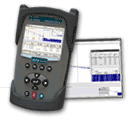
Advanced
Fiber
Solutions has introduced a new compact portable OTDR
that offers high resolution (to 1m) and light weight
(1.6 pounds, 0.72 kg) plus numerous wavelength and
range options. Here
is more information.
Magnetic Cable Management Hardware
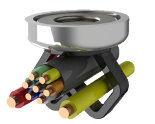
Mounting
hardware for cable management in equipment or telecom
rooms can be difficult - what do you attach things to?
But RES has a unique idea - use magnets to hold the
hardware on racks or any metal parts. Neat
idea, see their products here.
Micro-Trenching, Cable Removal
Nano-Trench
offers products for micro (or I guess they call it
nano-) trenching and their
website is very informative. They also have Kabel-X,
a method of extracting copper cables from old conduit.
Both websites are informative and interesting. Watch
this video on the cable removal process!
Protecting Pedestals From Rodents
Pedestals
and
underground vaults can be damaged by rodents who come
up through the base and damage cables. Uraseal "Drain
N'Seal" foam deters mice from taking up residence in
your pedestals. They
have some good videos on using their product.
A Cable Tie That's Fiber Friendly
We're always
warning installers not to tighten cable ties too tightly
around fiber optic cable (or UTP copper cable either!) A
better choice is the hook and loop fastener ties (Velcro
is one trade name), but there is another type, the
Mille-Tie. It's an open tie that can be used at any
length, then cut off and the remainder used also. Take a
look a the video to see how it works.
Mille-Tie Video: http://www.youtube.com/watch?v=QPVTQGKmcvE
Used Test
Equipment – Buy or Sell
http://www.testequipmentconnection.com/
Have you read the FOA
Tech
Topics on Cleaning?
More links on cleaning:
Westover
- AFL
ITW
Chemtronics
Cleantex
Alco Pads
MicroCare
Seiko-Giken
-
- FTTH
Notes:
Broadband Properties: Latest
Issue has lots of FTTx News.
Google Map Shows Worldwide FTTx Projects
One of the better sites to track FTTx projects is this Google maps
application that shows projects on a world map with details on the
project.

Click on the map above or here
to view the interactive web map.
Testing FTTH
JDSU shows how to test a PON with an OTDR: http://www.jdsu.com/other-literature/PON-OTDR_fop_an_ae.pdf
-
- Want To
Learn More About FTTx?
- The FOA has created a
special FTTx
resources section of our website with a FTTx
links page with lots of links to news, market reports,
technical articles and vendor technical and product
information. Here
is a great place to start learning more about FTTx.
- FOA's
CFxT FTTx Certification Program Explained
- Read
the Broadband Properties article about the FOA FTTx
certification program. Read
the
article about FOA President Jim Hayes being honored for
his work promoting FTTH.
-
|
-
Employment
New: Jobs Blog
Using
Social Media to help find your next job
According to CBS News.com, Facebook alone had over 700
million users who spend about 750 billion minutes on the site
per month. Twitter reported over 360 million users in late
August 2011. As of early 2012, LinkedIn has recorded
over 140 million users on their professional network. The
list goes on and on with Social Media sites that are attracting
millions of new users each year.
Over 80% of today's stakeholders use social media for recruiting
personnel. A large portion of these new age employers have
found success using sites such as Twitter, Facebook and
LinkedIn. In fact, more companies are investing time and
budget on social media recruiting in 2012 than any previous
years.
Other Social Media job seeking facts: In 2010, 92% of active
hiring managers used social media networks for recruiting.
Click here http://bit.ly/HoebVq
to read the full article on Social Media job seeking tips by
Scott A. Coulter, CSS
Visit my blog at http://apsicorp.net/?p=5422
for the 10 tips and more about Employability Branding for
Telecom Professionals.
Scott
Coulter is the founder and Chief Executive of APSi. Mr.
Coulter is an Author, Entrepreneur and Leader with over 20 years
of experience in IT Staffing, writing curriculum and providing
consulting services to clients around the U.S. and
internationally.
FOA Jobs Website
We
get many questions from CFOTs, students at FOA-Approved schools
and others contemplating getting into the fiber optic business
regarding jobs in fiber optics - and how to find them - so we’ve
created a new web page to share some information we've gathered
about jobs in our industry. The information is designed to help
you understand what jobs are available in fiber optics, how to
find them and apply for them.
While the
overall economy is pretty bad - you've probably heard that there
are 5 times as many people unemployed in the US as there are
jobs available, telecom is a bright spot - broadband is a major
focus of stimulus spending in the US and countries around the
world are building fiber networks as fast as possible. Even
wireless companies have to build fiber for their backhaul.
Cities are installing fiber linked surveillance cameras and
smart traffic lights. Fiber is the link making Smart Grid
possible. Companies like Allied Fiber are building large private
networks. Telecom is one of the fastest growing businesses
worldwide.
If you
are looking for a job in fiber optics, here is the
FOA's guide to jobs.
The FOA has created a group on  expressly
to help our CFOTs find employment and contracting
opportunities. If you are a CFOT and are interested in
participating, join us on
expressly
to help our CFOTs find employment and contracting
opportunities. If you are a CFOT and are interested in
participating, join us on  .
If you have job openings, let us post them on .
If you have job openings, let us post them on  . .
A
list of 10 ways to get your resume noticed from
Marketplace on NPR
Jobs Created As Part
of Stimulus-Funded Projects
The
federal government is spending 7.2 billion dollars on the
Broadband Technology Opportunities Program. This money
is working it's way into the economy and hopefully will
provide jobs. You can track recovery dollars and look
for job opportunities on this website: www.recovery.gov
Go
to "opportinities" link then "jobs". You will see a
section “find recovery jobs” – enter “fiber optic jobs
California” or wherever you are and review what comes up.
One of the projects funded by stimulus money is the 1100
mile network of Maine
Fiber Company Inc. which has selected nextGen
Telecom Services Group Inc. as the installation
contractor. CFOTs:
NextGen has a link on their website for applying for
jobs
Job
Openings
FOA
Instructor
Certified
Fiber Optic Instructor to teach CFOT, Oklahoma City, OK
Date
posted: February 27, 2012
ERI seeks
immediate part-time contract instructor to teach 40-hour
Certified Fiber Optic Technician (CFOT) certification course to
adults in the Oklahoma City workplace. Adult teaching experience
required. Hands-on experience involved. The course has two
components: A theory component and a hands-on component where
emphasis is placed on the practical aspects of working with
fiber optic cables, including connectorization, fusion splicing
and testing. Hourly instructional rate plus paid preparation
time.
Contact
Heather Blake, heather@educationalres.com
Educational
Resources, Inc.
45064
Underwood Lane, #200
Dulles,
VA 20166
USA
Tel:
703-904-1800
Fax:
703-904-1856
http://www.educationalres.com/
Recruiter
Looking For Fiber Techs
Seeking
Fiber Analyst for long term role based in Mountain View, CA.
Excellent
pay and benefits, GREAT team and work/life balance.
Job
Summary
Industry
Test Standards/ Protocols/Methods: Telcordia SONET
OC-48/192/768, GR-468-CORE, GR-1209, GR-1221; ITU G.709, ITU
G.651, ITU G.652, ITU G. 653, ITU G. 654, ITU G. 655 LAN/WAN,
GigE, MIL-STD-217 & 883, ISO-9001, SCSI, Fiber Channel,
Telcordia SR-332 Reliability, FMEA, RoHS, DWDM
Strong
technical knowledge of DWDM based optical transmission systems
design (Networks, Devices, and Technology), component
qualifications, system simulation and link budget analysis.
Good
OTDR/PMD/CMD/ORL/Insertion Loss/Attenuation test experience
skills
Fiber
testing, CD, PMD, OTDR, ILM.
Fault
finding.
Analysis
of Fiber Optic Test Results.
Design
and execute system test plans.
Survey
existing fiber networks to enable the production of new fiber
designs.
Implementing
engineering scope of work.
Perform
formal and informal training on solutions and technology as
required.
Document
results of tests and system designs. Communicate results,
issues, next steps, etc. to partners, customers, and
management as needed to resolve problems.
Acceptance
Testing.
Perform
other duties as required.
Bachelors
degree in Computer Science, Electrical Engineering or
equivalent work experience referred.
Required:
Three to
5 years DF testing, Fiber Analyst.
Excellent
communication skills.
Strong
customer support skills.
Ability
to troubleshoot complex FC issues to resolution.
Knowledge
of ODF, Patch Panels.
Knowledge
of DF types.
Eligible
to work in the US without sponsorship.
Accreditation/certifications/licenses
SCTE
IEEE
CCNA,
CCIE, etc.
Working
Conditions/Travel
Requirements
Normal
office environment.
Travel to
other locations as required. Travel 80 to 85%.
Plan,
facilitate and manage expansion work in Data Centers, POP’s.
It’s
long term (couple of years), about $45 per hour, maybe a bit
more for the right person.
Plan,
facilitate and manage expansion work in Data Centers, POP’s.
Work closely with the technical negotiation team to understand
terms of existing and new contracts and arrangements including
delivery targets and specific technical requirements related
to space, power, cooling and rack build out, DF, OSP, ISP.
Communicate target completion dates and ensure that all
internal requirements are being met in a timely manner.
Strong
project management skills to serve as primary vendor contact
for the delivery of space, power, HVAC, racks, cabinets, dark
fiber for new builds and expansion of existing sites.
Technical
knowledge of DWDM based optical transmission systems. Strong
knowledge of Telcordia GR 1275, 1502, 2981, NFPA
requirements.
Strong
understanding of interconnectivity requirements within carrier
hotels including LOA/CFA, physical interfaces, cable types,
connector types. Strong understanding of risers and all
aspects of ISP.
Strong
Experience with planning and delivery of space, power, cooling
and inside plant fiber, risers, routes and documentation of
same. Strong Experience with AC Power, UPS, Rectifiers, DC
Power, Battery Plant, HAVC, Grounding.
Strong
skills in development of Statements of Work (SOW), MOPs
and an understanding and managing vendor provided handover
packages – project managing internal teams to qualify handover
packages
Hands On
background in proper fiber cleaning procedures, radius bend
and fiber running procedures. Connector types, fiber
management, understanding, use of light meter, light
source, understanding of OTDR shots.
Good
understanding of OSP and interconnection hand off between OSP
and ISP.
Demonstrated
organizational project tracking and communications skills.
Proficient
with laptop and Windows applications.
Strong
Telco background
80%
travel required.
BS Degree
in a technical discipline or 6 years in a telecom related
field.
Strong
Project Management, Communications Skills along with Strong
Personal Relationship
Ability
to read and understand engineering provided drawings and wire
list. Visio, Excel,
Working
Conditions/Travel - Indoor and outdoor environments. 50% - 80%
travel required
More
Jobs For Techs
I’m
looking for a couple of techs for a 2+ year project that’s based
in NorCal doing trace analysis and audits nationwide. As the pay
range is between $35-40 per hour, this would be a good
opportunity for someone who has the training and experience and
is certified.
I’m also looking for a couple of FTTx Design Engineers for a
contract-to-perm role in Lincoln… these are just a couple of
examples of what I’m hiring for.
Contact:_______________________________________________________
Tami
Brittain | Technical Recruiter | Comforce Telecom
15305
Dallas Parkway Ste 250 Addison, TX 75001
Phone:
972-866-5145 | Cell: 972-217-5912
Email:
tbrittain@comforce.com
Fiber Optics Engineer/Technician (Feb 2012)
Are you crazy about new technology and how the
communications space is changing to meet the expanding
bandwidth requirements in the communication age? Have you
spent five plus years in the field working directly with
fiber and service providers and want to move into a
product development role that solves problems up front? If
working with a dynamic team and some of North America’s
top triple play service providers is a direction you want
to take your career, please email a covering letter
stating your experience and your resume to dhammersley@vplenterprises.com.
A little About Us:
Primex Telecom is a division of VPL Enterprises Ltd, a
plastic injection-molding company that specializes in the
manufacture and distribution of telecommunication and
building products. Primex specializes in developing,
producing and distributing flexible enclosure solutions
for the cable and
telecom industries. We offer turn-key and OEM solutions
for CATv, Copper and Fiber termination boxes in a series
of off-the-shelf products as well as ready-to-install
customized enclosures. At Primex, we makeeverything fit –
so you don’t have to.
Description:
You will work collaboratively with internal teams and
customers to build on product offerings using existing
ideas, and will use your industry experience to prioritize
and develop new features and designs. You possess a unique
blend of business and technical acumen and have the
ability to see the ‘big’ picture. You have the
determination to make the company’s vision a reality and
enjoy spending time in the market to understand customer
issues and develop innovative solutions.
General Duties and Responsibilities:
To work in close collaboration with Telecom sales,
engineering, customers and prospective clients to design
and build market ready optical fiber, copper, wireless and
OEM network termination, demarcationand connection
enclosures. Assist in strategically sourcing specified
components and alternates and follow through to completion
all relevant certification processes and requirements for
the Telecommarketplace. The Fiber Optics
Engineer/Technician is the technical sales support
resource responsible for working with front line sales
teams, marketing, customers and engineering teams to
conceptualize,design and execute the development and
market acceptance of Primex solutions.
Responsibilities: Capturing detailed requirements and
ensuring that our internal mechanical engineering team
understands all requirements & develop products that
are consistent with our brand and appropriate for the
marketplace.
Direct relationship management with external customer
engineering teams to develop solution- focused products.
Building and maintaining business relationships with any
partners and suppliers necessary to ensure the success of
the products, including vendor selection.
Research and analyze customer design proposals,
specifications and other data to evaluate the feasibility,
cost, and maintenance requirements of designs or
applications.
Assess customer network specifications and assist in
procuring specified components and work towards value
engineering part substitutions where possible to increase
value.
Specify system components or direct
modification of products to ensure conformance
with engineering design and performance
specifications.
Perform research and report on competitive
products; assist Marketing and Sales with
developing differentiating product positioning
strategies.
Provide technical customer service in
coordination with Sales as required.
Train internal staff on market trends, new
technologies and specifically the expanding role
of fiber optics in the communications space.
Required Skills and Qualifications
This role will require someone with
extraordinary technical abilities gained through
on site field experience. An academic background
in Electrical Engineering would be highly
relevant. Direct multi-year, OSP experience in
the telecommunications, fiber optics and cable
television market space.
Solid understanding of the telecommunications
market and specifically the role of fiber optics
in relation to FTTx market.
Direct experience with the last mile equipment,
termination and technologies – Fiber and Copper.
Thorough understanding of role and evolution of
both active Ethernet and PON networking systems
as well as working familiarity with RFoG systems
and new triple play technology developments.
Familiarity with compliance engineering, UL,
CSA and/or Bellcore/Telecordia.
The ability to research and anticipate
technology trends is essential in addition to
understanding competitors and their ‘roadmaps’.
Strong problem solving skills along with
excellent verbal and written communication
skills. Intellectual curiosity, creativity and a
passion for technology would be advantageous.
Project management skills demonstrated through a
PMP designation or work experience. Demonstrated
ability to understand and develop plans and
strategies to clearly communicate complex
business issues and technological solutions.
Fluent communication skills in English both
written and oral.
Ability to effectively work with
cross-functional teams and various geographical
locations. Willingness and ability to travel
within North America to support Sales and
Marketing efforts.
This position will be based at our Primex
Headquarters in Vancouver/Langley, BC, Canada.
Check out our website at http://www.primextelecom.com/
to learn more about our company and our flexible
enclosure solutions for the communications
space. Interested and qualified candidates should
email Donovan Hammersley, VP of Sales and
Marketing, at dhammersley@vplenterprises.com.
Only qualified candidates will be contacted for
future follow up.
Communications Installation Technician in Alaska
(Feb 2012)
We have an immediate opening for a Communications
Installation Technician in the Alaska market. We
are also expanding our installation crew in the PNW
market and would like to interview candidates for open
positions.
Jay Lewandowski
Install Project Manager
Steelhead Communications Inc.
(206) 384-5960 Cell
WASHINGTON CORPORATE OFFICE
28120 State Route 410 East
Buckley, WA 98321
(360) 829-1330 Office
(360) 829-1320 Fax
jay@steelheadcom.com
ALASKA OFFICE
700 West 58th Avenue
Unit J
Anchorage, AK 99518
(907) 569-0003 Office
(907) 569-0013 Fax
FOA lists jobs and
contracting opportunities on our LinkedIn
group. CFOTs are invited to join.
Do
listings in the FOA Newsletter Work? Here's feedback:
"We did great! We have over 15 interviews next
week."
"Your newsletter generated a significant number of
applicants and we have filled the position."
|



